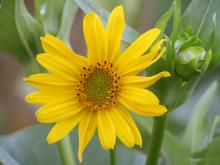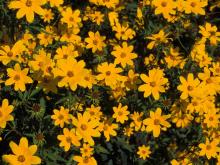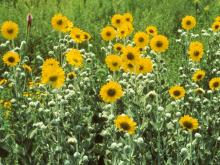Wildflowers, Grasses and Other Nonwoody Plants
Media

Species Types
Scientific Name
Dioscorea oppositifolia (sometimes called D. batatas)
Description
Similar to kudzu, Chinese yam is an aggressive vine that overtakes nearly everything within reach that stands still long enough! Learn more about this invasive plant — and please don’t plant it!
Media

Species Types
Scientific Name
Najas spp.
Description
Naiads are slender, narrow-leaved plants that grow completely under water and are rooted to the bottom. They never have broad, floating leaves or conspicuous flowers or seed heads.
Media

Species Types
Scientific Name
Silphium perfoliatum
Description
Called carpenter’s weed for its remarkably square stems, cup plant is also notable for its large, opposite leaves that fuse around the stem to form a leafy cup that holds rainwater.
Media

Species Types
Scientific Name
Ambrosia trifida
Description
Large stands of wind-pollinated giant ragweed commonly form in disturbed areas, causing late-summer misery in the form of hay fever for many Missourians.
Media

Species Types
Scientific Name
Bidens aristosa
Description
Tickseed sunflower has flattened black seeds that attach themselves to clothing and pets via two needlelike awns. In flower, it grows in massive displays in moist bottomlands.
Media

Species Types
Scientific Name
Lysimachia lanceolata
Description
You can find small colonies of lance-leaved loosestrife nearly throughout the state. It has showy but nodding yellow flowers and opposite, closely spaced, lanceolate or ovate leaves.
Media

Species Types
Scientific Name
Helianthus tuberosus
Description
Jerusalem artichoke deserves a better common name. This tall native sunflower has edible tubers and great crop potential, but it has never been very big commercially. Fortunately, we can enjoy it for free in nature.
Media

Species Types
Scientific Name
Euphorbia commutata
Description
Conspicuous in early spring, wood spurge is a dainty species with loose clusters of small, light green flowers. Look for it in woods, valleys, streamsides, and waste areas in Ozark landscapes.
Media

Species Types
Scientific Name
Helianthus spp.
Description
Most people recognize sunflowers when they see them, with their bright yellow ray flowers and rather flattened center of dark disk flowers. There are 16 species of Helianthus in Missouri.
Media

Species Types
Scientific Name
Verbesina alternifolia (syn. Actinomeris alternifolia)
Description
Yellow ironweed is a tall native perennial wildflower. Its yellow petal-like rays droop down, making the many flowerheads look like small, ragged sunflowers. The stems are winged, especially toward the bottom of the plant.
See Also
About Wildflowers, Grasses and Other Nonwoody Plants in Missouri
A very simple way of thinking about the green world is to divide the vascular plants into two groups: woody and nonwoody (or herbaceous). But this is an artificial division; many plant families include some species that are woody and some that are not. The diversity of nonwoody vascular plants is staggering! Think of all the ferns, grasses, sedges, lilies, peas, sunflowers, nightshades, milkweeds, mustards, mints, and mallows — weeds and wildflowers — and many more!





















